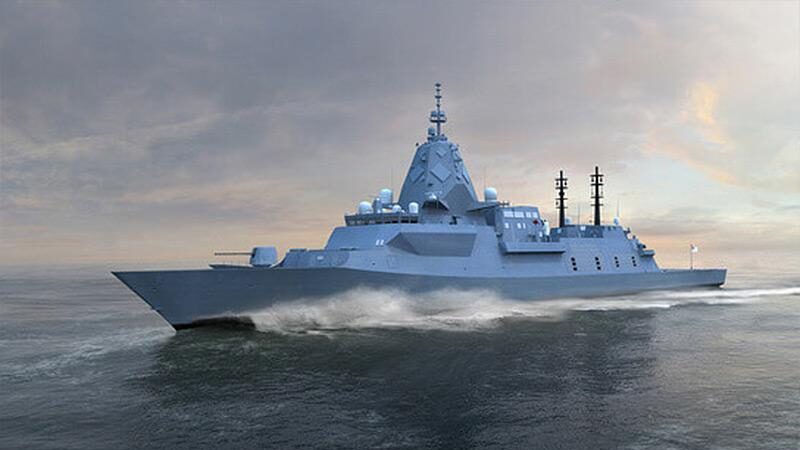
Concept art of the forthcoming Hunter-class frigate. (ANAO)
SYDNEY — Australia’s national audit office has delivered a highly critical report on the decision to choose the Type 26 as Australia’s new warship, declaring the Australian Defence organisation did not conduct an effective process in choosing the design.
Defense officials did not assess overall value for money of the three competing designs, according to a lengthy report published by auditors last week. Nor did the officials maintain adequate records of the ultimate decision to choose the BAE Systems’ Type 26 Global Combat Ship over two competing designs — in essence, making it impossible for the public to understand the decision-making that went into the selection.
“The hallmark of Defence’s management of this procurement and related advisory processes is that they lacked a value for money focus, and in that sense the procurement did not comply with the core rule of the CPRs (Commonwealth procurement rules),” the Australian National Audit Office (ANAO) said in the report. “The origins of this approach — which was reflected in the 2017 Tender Evaluation Plan — are not transparent, due to the shortcomings in Defence record keeping observed in this audit.”
RELATED: Australia ‘massively dropped the ball’ on defense spending, Beazley warns
ANAO is the Australian equivalent of the US Government Accountability Office, and its lengthy reports are generally fact-laden, authoritative and dry — meaning the language included in this report, while full of bureaucratic speak, is actually fairly damning.
The tender evaluation for these nine new warships, termed the Hunter-class, might be forgiven its shortcomings if the project was running on time and on budget. It’s not, with a delay of 18 months because of immaturities of the design and the impact of the Covid-19 pandemic. It’s also costing more.
In January, the defense Surface Ships Advisory Committee said Type 26 design maturity was over-stated and therefore the extent of cost and schedule risk was under-estimated.
Under project SEA 5000, the Royal Australian Navy is acquiring nine anti-submarine warfare (ASW) frigates to replace eight Anzac-class frigates. These will be constructed wholly in Australia at a new line in Osborne, South Australia.
RELATED: In China’s shadow, new Australian defense review focuses on denial, long-range weapons
The BAE Systems design was chosen following a three-way evaluation against the Italian Fincantieri FREMM and a modified version of the Spanish Navantia F100.
Both were mature designs, with the FREMMs in service with France and Italy and on order for the US Navy, and the F100 a derivative of three Hobart-class DDGs built in Australia.
BAE Systems pitched the Type 26 ASW as an ultra-modern digital design that the UK Royal Navy was acquiring first, mitigating design risk for Australia.
In 2018, the Australian government announced the winner was BAE.
The Australian military advised the government that the primary reason for that choice was superior ASW capabilities. There was just a 4 percent cost variation across the three bids, according to ANAO, but considering the estimated $45 billion AUD ($30 billion USD) price tag, that 4 percent accounts for hundreds of millions.
Significantly, the Australian government saw construction of the new warships as central to its plan to create a national shipbuilding industry.
So far BAE is only contracted to stand up initial design and production, though that head contract, signed in 2018, has increased by $693 million AUD to $2.56 billion AUD thanks to 93 contract change proposals approved by Defence — 36 of which impacted the price. Production of vessel number one starts next year and then production is expected to proceed in three batches of three ships on a two-year drumbeat with additional contracts.
In its reply to the ANAO’s preliminary findings, Defence disagreed that procurement lacked a value for money focus.
“The value for money assessment is inherent throughout Defence’s management of the naval shipbuilding enterprise and, through this lens, the progress of the project between first and second pass. Defence recognises that value for money is not solely determined by the price,” it said.
But ANAO said Defence had conflated an industry policy objective of establishing a continuous naval shipbuilding program in Australia with actually achieving of value for money in procurement.
What will be the consequence of these findings? Maybe some additional education for officials, but otherwise not much.
Perhaps the worst outcome will be an embarrassing public grilling at an upcoming hearing of the Senate estimates committee, where Senators have carte blanche to interrogate officials at length on project shortcomings.
“Defences’s general approach to applying the CPRs (Commonwealth Procurement Rules) and the core principle of value for money in the Hunter class procurement, and the lack of understanding of CPR requirements reflected in its responses to the ANAO, suggests that further training and oversight may be required of Defence officials involved in high-level planning and advising on major capital acquisition projects, at all levels,” ANAO said.
With the 2031 in-service date for the first Hunter looking less likely to be achieved, Navantia has stepped in with a pair of unsolicited proposals, one to build three more Hobart-class DDGs and the other to build six corvettes. The Australian military has engaged the RAND corporation to assess the proposal for three additional DDGs.






















